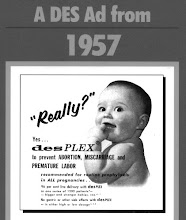 WHAT HAPPENED IN AUSTRALIA?
WHAT HAPPENED IN AUSTRALIA?1964 - In the wake of the Thalidomide tragedy, the Adverse Drug Reactions unit and Australian Drug Evaluation Committee are established. The Medical Journal of Australia states Australian doctors are aware that care should be taken in prescribing drugs for women.
1971 - Oct 15, information from US arrived in Australia about cancer link to DES (clear cell adenocarcinoma vagina/cervix).
1972 - Sept 9, Therapeutic Goods Administration's (TGA) warning about DES appears in Medical Journal of Australia.
1973 - A national register of DES cancer cases is recommended by TGA committee, but did not eventuate.
1975 - Further warning appears in Adverse Drug Reactions Bulletin (TGA).
Late 1970s - Failure by doctor to report DES cancer in two girls is revealed. At least five children at one children's hospital with likely DES exposure are not investigated. TGA made decision to keep medical profession informed, rather than release statement to lay press. Media release is thought to risk practical problems and public alarm.
1976-1979 A few articles about DES appear in lay press.
1981 - Australia's only DES Clinic established in Melbourne. Its promotion is not mandated. The clinic's listing of patients is purported to be a State Register. Article in Medical Journal of Australia states: A major problem in this country is that there is no recall system which could identify those pregnant women given DES. This Journal alerts doctors of increased risk of unfavourable outcome of pregnancy in DES daughters.
1983 - Reporting of DES cancer cases to TGA is stymied for almost two decades and remains static with only 4 cases. TGA was informed by a doctor that gathering reports by TGA is unnecessary and so TGA complies with this information. Australian media cites 10 cases, sourced from RANZCOG.
1984 - Research shows increased risk of breast cancer in DES mothers.
1995 - DES Support NSW was established, re-named as DES Action Australia-NSW, and again re-named as DES Action NSW in 2013.
1997 - Government commissioned report states probably only 1 case of DES cancer in Australia and provides little justification to keep the DES community informed. Available data (AIHW and State Cancer Registries) in 1997 indicates between 25 and 88 cases.
1998 - At request of DES Action NSW with a government grant, Cancer Council NSW distributes DES information targeting NSW women. Minister for Health & Aged Care states:...a general publicity campaign for DES exposed people to identify themselves would create anxiety without tangible benefit. Cancer Council NSW ceases DES information distribution as the information is "too scary" for women.
2001 - The Strategic Communication Plan for the US Centers for Disease Control's DES National Education Campaign as a model for Australia is ignored by the Minister for Health & Aged Care.
2004 - TGA issues a Bulletin item giving interim advice (until government completion of a review re DES exposure recommendations) that DES daughters follow the same cervical cancer screening as for the unexposed population. This "interim advice" is inadequate for the early detection of DES associated clear cell adenocarcinoma vagina/cervix. A media release was also issued generating publicity with inaccurate information that DES cancer risk had passed. RANZCOG spokeswoman, Dr Margaret Davy states in interview (The World Today-ABC Radio, 28/6/04 12:34) that in Australia, less than 1,000 women all up would have been exposed to DES as miscarriage treatment. She adds that given there are 10-15 cases of clear cell adenocarcinoma of the vagina reported in Australia, DES was not a big problem. Government correspondence to the DES Action group states promotion of DES information may create community anxiety and refuses to directly inform the public about DES in health promotion programs.
2005 - TGA's Bulletin (which targets medical professionals) reports on screening guidelines for DES daughters. There is no media release issued in relation to this Bulletin item.
2006 - Research shows DES daughters over age 40 have increased risk for developing breast cancer.
2008 - Legal assistance sought by DES Action NSW, following four years unsuccessful lobbying to have TGA's 2004 media release misinformation addressed. TGA then issues a Safety Alert and media release with the correct information, including 2006 research finding regarding increased breast cancer risk in DES daughters and their need for annual mammography. No media interest transpired. Australian woman wins a legal battle with DES manufacturers in USA.
2010 - By acquiring data of instances of clear cell adenocarcinoma of vagina/cervix from the TGA, Australian Institute of Health & Welfare, and former State Cancer Registries, DES Action NSW estimated up to year 2010 there are 168,000-740,000 DES mothers, daughters and sons in Australia. Based on average projected cases this figure could rise by 20,000 per year.
2011 - Matter of Government failure to properly inform Australians about DES is relayed to Australian Human Rights Commissioner by DES Action Australia-NSW. The Commission acknowledges the importance of ensuring DES exposed people have full information, but does not have the resources to advocate in the DES matters raised. This year marks 40th Anniversary of the DES cancer link. The US FDA declined to issue an apology for DES, but acknowledged DES exposure as a "tragedy". Yet still, DES information remains buried in Australian Government websites. The majority of the estimated 740,000 DES exposed Australians remain unaware of the danger of DES and the special vital preventive health care they need.
2013 - The Australian Senate responded to questions about the DES exposure issue. Australian Senate However, these questions were not painstakingly answered.
Please view the DES Action USA Key Events at http://www.desaction.org/timeline.htm

No comments:
Post a Comment